
THE 5G REVOLUTION IN CONNECTED MOBILITY AND INDUSTRY 4.0, AT THE FOURTH DAY OF THE 5G FORUM
The fourth day of the 5G Forum 2022 has had the presence of large multinationals such as Orange, Telefónica, Capgemini Engineering, Dekra, Viavi Solutions or Gamma Solutions that have exposed real cases, in different sectors, based on 5G technology.
The fourth day of the 5G Forum 2022 was opened by Pere Vila, President of UHD SPAIN, who spoke about the state of 5G technology in the audiovisual sector and the ultra-high definition broadcasts that are being carried out: “We are a little expectantly, we are aware that the first 5G backpacks have appeared this year. I think that this year 2022 may be a little fair ”. However, for Vila, the year 2023 is key because “we will be able to carry out tests of capturing and transporting ultra-high definition signals using 5G. Next year we will be able to capture, transport and even produce in the cloud hand in hand with some of the companies that carry it out”.
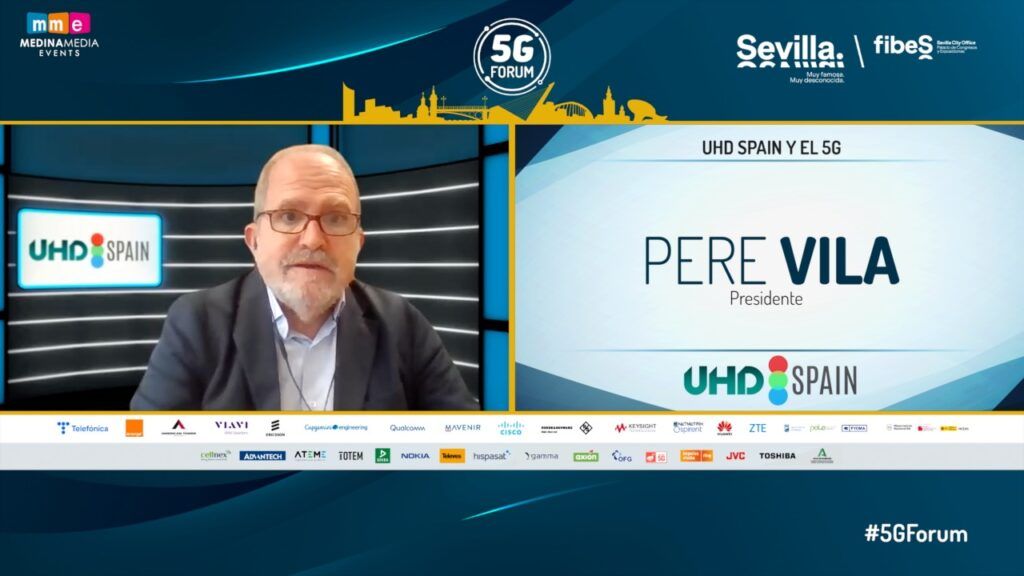
In spite of everything, Vila has commented that at the MWC they have already carried out high-definition emission tests, using the 5G emission standards: “We are going to make an effort to deploy 5G and thus be able to evaluate the diffusion part on 5G, but using Ultra HD. There is a link between the two worlds.”
Finally, the President of UHD Spain has advanced that he is going to launch a new version of the White Paper that “already includes new aspects of what we have been working on together this year. We have already done several webinars, we have focused more on production issues, lighting issues, audio issues and we have also published some papers. All this can be found on the UHD Spain website and if these projects move forward, the idea would be to also be able to enter a fusion between these issues between HD and 5G “
After Vila, it is the turn of Federico Ruiz, Head of the National 5G Observatory, who has carried out an in-depth analysis of the state of 5G and its path towards 6G; affirming that private networks are taking center stage: “One of the first trends for some interlocutors is private networks. Very much in line with what has been the priority for funds and deployment in Europe and in Spain is vertical, industrial 5G or 5G of private networks. A second big trend is the 5G supply chain.”
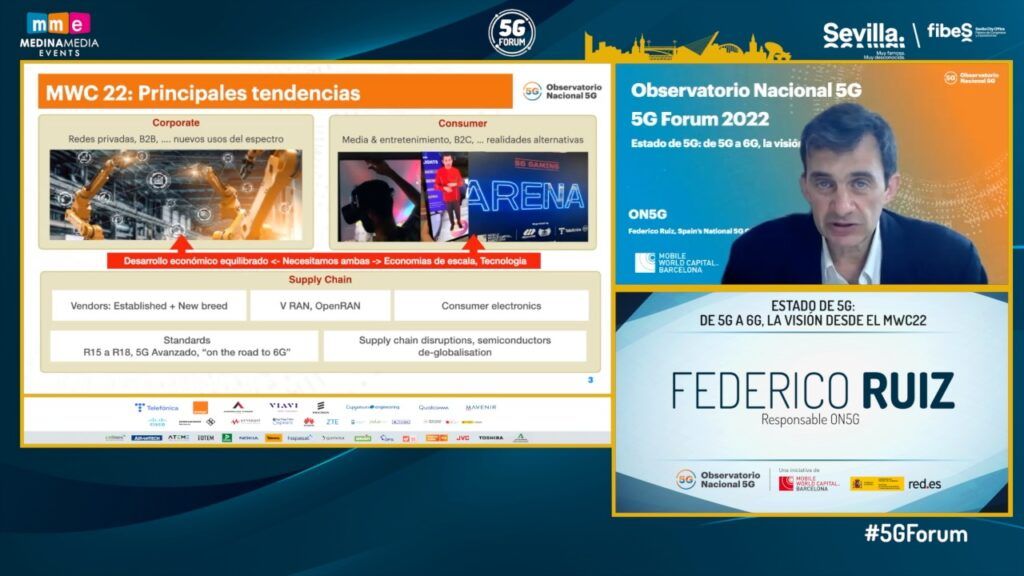
Ruiz assures that the appearance of new players points to an increasingly powerful and rich 5G ecosystem “but new difficulties also arise, such as with what funds we develop these new features.” For Ruiz, a reliable supply chain is essential for the definitive development of 5G in the industrial sector: “There will be no development of industrial 5G without development of consumption, because it is consumption that brings the economy of scale and the technology to make advance 5G”.
The use cases of Orange and Telefónica
Subsequently, the turn of the large telephone companies worldwide, Orange and Telefónica, has come. Through two sessions in which different speakers spoke about the 5G world.
The French multinational Orange has reflected on the potential of the Mobile Private Network over 5G with Abel Carbonell, Head of Electronics, ADAS and Connected and Automated Vehicles, Idiada; Enrique García, Ericsson Sales Director for Orange; Javier Olveira, Orange B2B Presales Engineering Director and Víctor Vera, Orange Business Territorial Director.
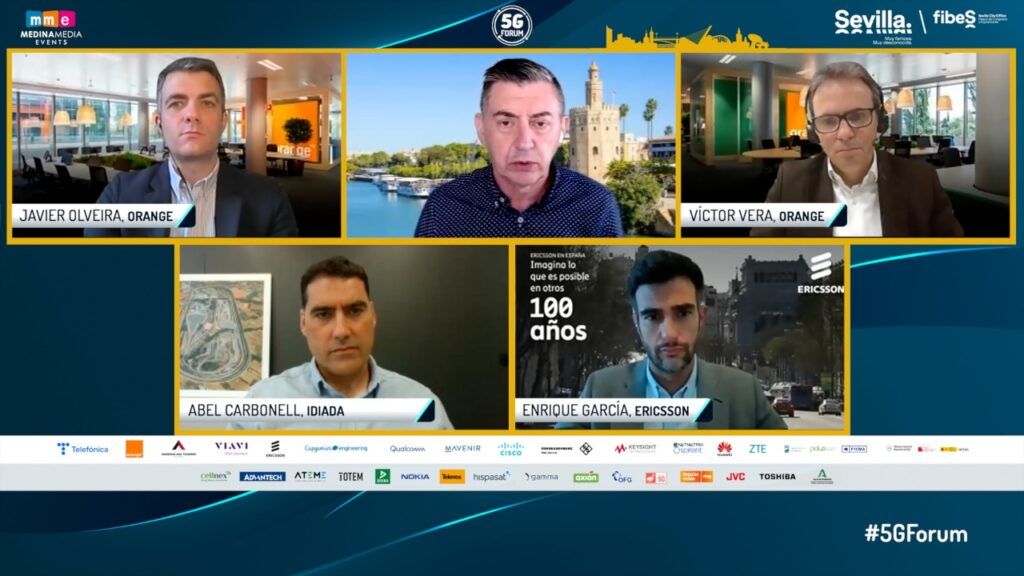
Vera, Territorial Director of Orange Companies, has announced one of the first real cases of a 5G mobile private network in Spain, the Idiada Project, within the automotive sector: “It arises from the confluence of three fundamental elements. In our case there is a longstanding link between Idiada, Orange and Ericsson. The project continues due to a need presented by Idiada and, of course, requires great effort and commitment over a long period of work by all parties involved.
Vera explained what the Idiada project consists of: “This project, focused on autonomous cars, has a private network with functionalities and spectrums that can be changed depending on its clients. It is a dedicated network for within the bounded perimeter, to test and modify network parameters. Pure innovation. This private network enables 5G and further development.”
Abel Carbonell, Head of Electronics, ADAS and Connected and Automated Vehicles at Idiada, stated that this project “puts us at the forefront at a European level for connectivity solutions in the automotive sector. We have many demands from our customers. It even opens many doors to other sectors that are not related to the automotive industry”.
For Carbonell, this project is a solution for manufacturers that receive many complaints about connectivity issues: “We want to solve these connectivity transitions. Connectivity technology will also make vehicles more secure, it is the next step”.
For Enrique García, Ericsson Sales Director for Orange, this project has made two things clear that have become a reality: “It has become clear that the 5G network is already here and, on the other hand, that Orange has the most advanced 5G network. advance of Spain.
Finally, Javier Olveira, Orange’s B2B Presales Engineering Director, described 5G technology as a Swiss army knife in terms of application: “It adapts very well to different use cases. It is a technology that for the first time offers secure and reliable networks and provides service with mobile technology. This is going to change society in the long term.”
After Orange, it is the turn of Telefónica and the University of Malaga, which have presented the different use cases in relation to 5G technology that they have been carrying out jointly for several years through Evolved 5G. David Artuñedo, Telefónica’s Innovation Team, Bruno García, Main Developer of the Evolved 5G – UMA group and Almudena Díaz, Researcher of the Evolved 5G- UMA project, participated in this presentation.
Artuñedo has commented that the companies that are going to face their digitization are going to require a combination of much-needed communication capabilities with the 5G network, such as “computing and storage resources, to process all the information that is going to travel through communication networks”.
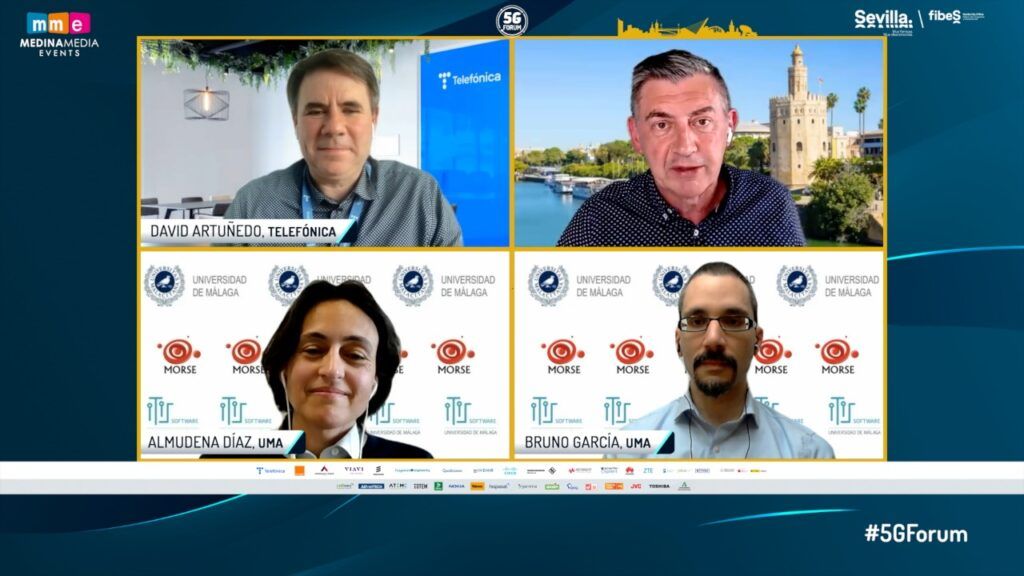
Artuñedo has affirmed that in the use cases that they are carrying out, together with the University of Malaga, they are already applying this recipe: “The sandbox that we have set up with the UMA already has coverage both in the area of the Lord Byron campus , such as in the center of the city, Calle Larios, and it is being extended to areas such as the port of Malaga or the municipality of Torremolinos”.
Bruno García, Principal Developer of the Evolved 5G – UMA group, explained that what they promote is the creation of an ecosystem of netapps: “They are applications that run within the operator’s environment and that have access to the functionality exposed by the core 5%. Each netapps exposes this functionality or any other functionality that might be interesting for a use case to the application layer without directly accessing the core interfaces.
García assures that this project has a clear objective: “Provide all the necessary tools for the Netapp life cycle, from the development phase until it reaches the end user.”
Almudena Díaz, Researcher of the Evolved 5G- UMA project, has also told us about the application of the technology in the agriculture sector: “We have a series of use cases, which do require 5G capabilities”. An example of one of the cases has been centered on the Finca del Mayoral in Malaga: “It studies various crops and how irrigation is carried out, its frequency, the type of fertilizer, the guidelines to follow and tries to identify which species is best adapted to to the climatology of the area and, therefore, it needs to collect a lot of data and images “
Large multinationals bet on 5G technology
Capgemini Engineering, one of the largest technology consultancies worldwide with more than 300,000 workers in more than 50 countries, has been a major player on this fourth day through a talk on industrialization and scalability in 5G use cases with some of its most powerful clients. Participating in this conversation were Luis Manuel Díaz de Terán, Vice President Division Director of Capgemini Engineering, Jose Antonio Hernández, Technological Strategy and Digital Program at Repsol, Alberto del Sol, Director of Marketing and Innovation Vodafone Business and Javier Martín, 5G Tech Manager at Elewit .
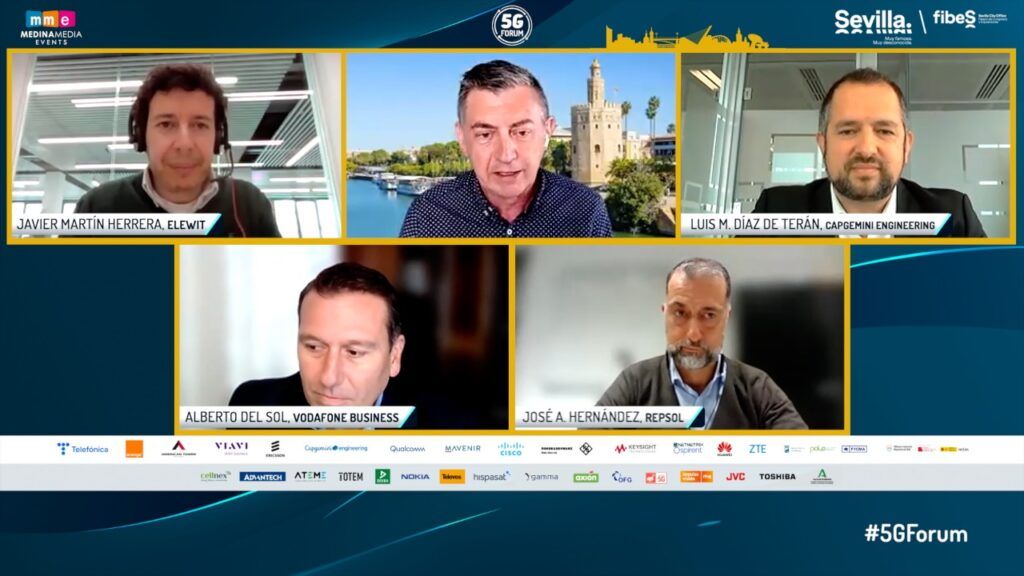
For Díaz de Terán, 5G is going to help change the industry in our country: “5G is a means that helps achieve this.”
Hernández, Technological Strategy and Digital Program at Repsol, stated that his company is immersed in more than 360 model cases in the use of digital technology: “We started our digital program in 2017. We have been exploring 5G technology for a few years now. We were the first European test bench with 5G”. And for this reason they are now in a process that is superior to other test benches, a scaling strategy: “5G is going to allow us to connect many more devices. And we think that it will be one of the levers to sophisticate the intensive use of Artificial Intelligence”.
Javier Martín, Tech Manager at Elewit, has presented 4 use cases in which they are working with Red Eléctrica: “In 2 of them it combines artificial vision and data management with remotely automated self-manned vehicles, the third is related to with coverage of the current terrestrial mobile 5G network via satellite and the last one is focused on what happens if we connect one of our cores with a medium with 5G”. With this technology, they intend to test the sending of data to make much faster decisions in the face of difficulties that may arise.
Finally, Del Sol, Vodafone Business Director of Marketing and Innovation, has reflected that 5G will be a success when the end user uses it and does not know what 5G is behind. “We see 5G in many sectors: virtual reality, big data, user experience… In short, it is a technology that breaks boundaries. 5G is also already present in security fields. 5G is a field open to multiple possibilities.
Viavi Solutions, an American network testing, measurement and assurance technology company, has been the protagonist on this fourth day talking about deploying 5G networks and services, but with quality and efficiency. Participating in this presentation were Maribel Ortiz, EMEA Channel Director of VIAVI Solutions, Genís Sánchez, EMEA PLM Director, Wireless Test of VIAVI Solutions, and Mercedes Fernández Gutiérrez, Independent Advisor, formerly – Innovation Manager of Telefónica Spain.
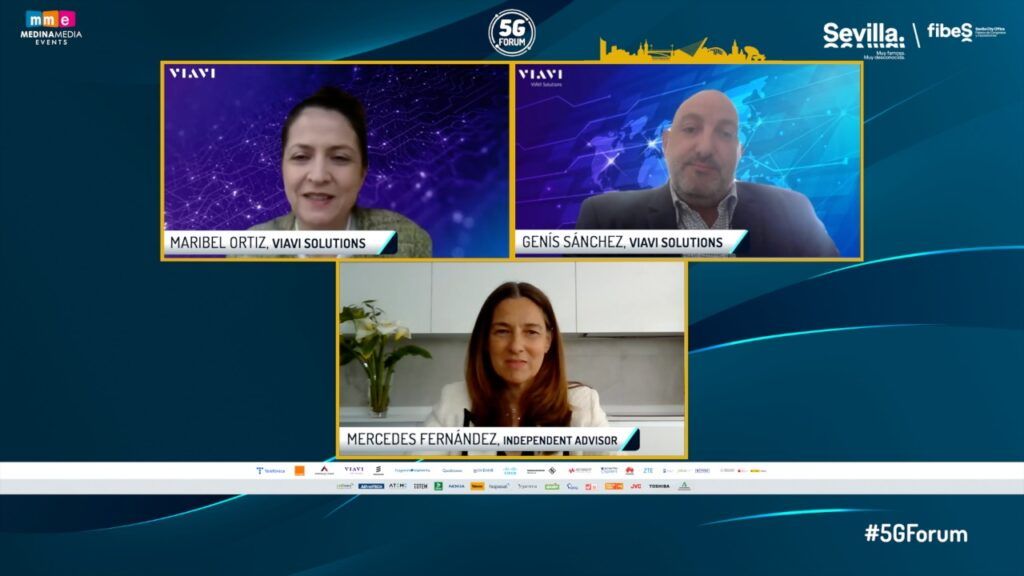
For Mercedes Fernández Gutiérrez, Independent Advisor, formerly – Innovation Manager of Telefónica Spain, this technology “is going to contribute to the transformation of the different productive sectors, of the different sectors of activity”, such as in the tourism sector: “we are seeing very interesting applications in the tourism sector, where we can promote all that heritage that we have in Spain with virtual reality applications”.
Sánchez, EMEA PLM Director, Wireless Test at VIAVI Solutions, has assured that 5G is a technology that is very sensitive to any aspect of “timing and synchronization” and if it is not “guaranteed that these networks that operate in parallel are correctly synchronized between them, generates interference and a drop in the quality of a service. These are situations that we are seeing with industrial private networks in some countries.” .
Finally, Ortíz, EMEA Channel Director of VIAVI Solutions, has concluded that for them, who are manufacturers, it is a great challenge to be with other new players, not only with the traditional ones: “new system integrators and even with new companies that we find our clients from another area of the company who want to take off with 5G”.
5G present in Industry 4.0 and geolocation
Francisco Mazo, Manager Network Services of DEKRA, has reflected on the benefits of 5G technology for Private Networks and has shown examples of value-added solutions that are being developed on different segments of the industry: “Cellular private networks have greater guarantees of security, because they will not have the impact of public networks and better control of information and privacy. As well as the flexibility to adapt to a changing environment such as the layout of a factory”.
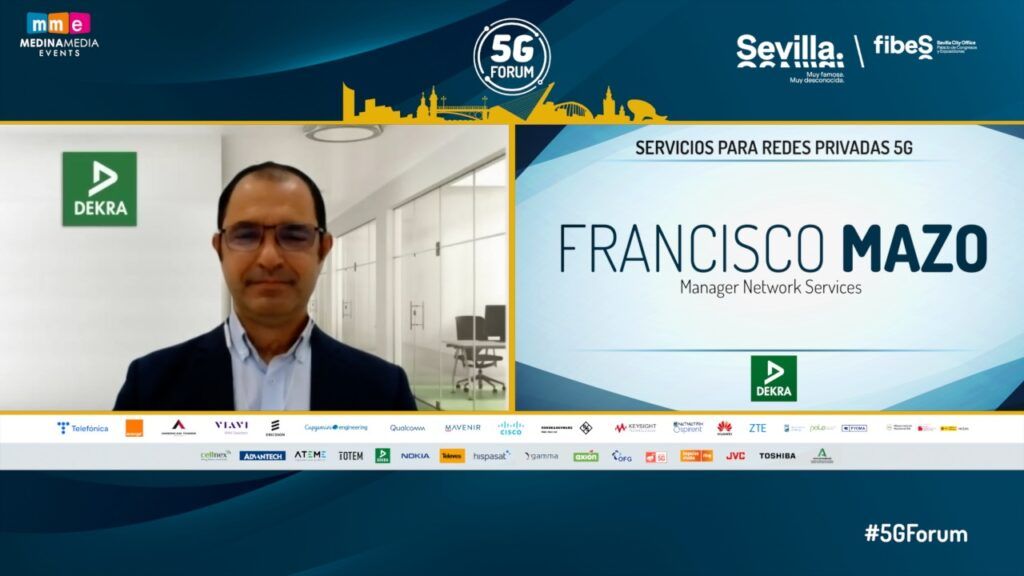
Mazo has stated that one of the applications of private networks is the possibility of applying the so-called industry 4.0: “This is the next industrial revolution that is characterized by a continuous flow of information between the physical and digital worlds. And this is possible thanks to new enabling technologies in terms of connectivity. 5G is one of them. We also have technologies such as the Internet of Things, artificial intelligence, robotics, Big Data or analytics in which solutions for industry 4.0 are already being deployed, such as sensors, automatically guided vehicles, augmented reality and reality virtual predictive”.
Finally, Mazo has ensured that industry 4.0 is present in different sectors, not only the industrial one, such as “mining or public transport”.
Next, Carmen Barrantes, Program Manager of Innovation & 5G at GAMMA SOLUTIONS, presented the Cáceres 5G project and its environment, fields of application and use cases: “We use geolocation to offer informative interactive information on the monuments that the user has around it. We take advantage of the low latency and high bandwidth of 5g technology and transfer the computation necessary to run mixed reality applications to a processing system, located at the apex of the network, what is known as edge computing or comes the cloud , what is known as cloud computing , which allows to reduce the size and computational requirements of the virtual reality glasses of the visitors”.
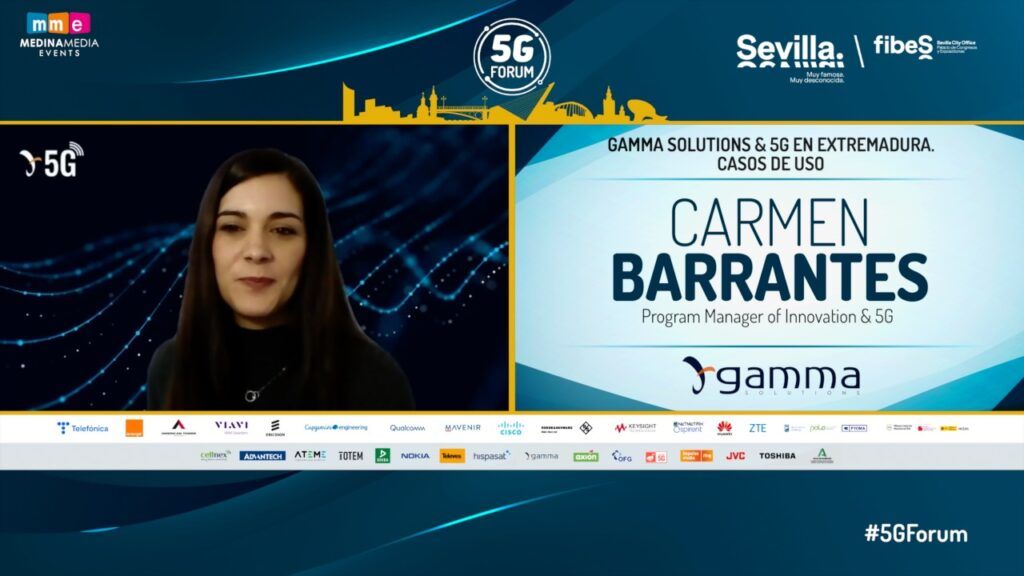
Barrantes has also announced that they have developed an application for remote driving of electric vehicles: “What we have done is adapt that vehicle by sensing it and in it all the local control and communication protocols with the outside are executed. The urban environment in which the vehicle travels is located on the campus of the University of Cáceres, in a localized section and in which there are elements that interact with the vehicle in real time, such as cameras, movement sensors, radars , proximity sensor etc… 5G allows the driver to experience in real time all the circumstances that may occur around the vehicle and make instant decisions”.
RTVE at the 5G Forum
To end this fourth day of the 5G Forum, Urbano García, Director of Innovation and Digital at RTVE, spoke about innovation and 5G on Radio Televisión Española: “We believe that it is essential to attend to the only reality regardless of whether we call ourselves radio or television, because we have to promote our windows in podcasts, on the web, in written texts, spoken texts, in still images, in moving images. That is to say, a 160° communication, breaking down the traditional vertical threads of interactive television, radio and digital to do it in a much more vertical and much more transversal way”.
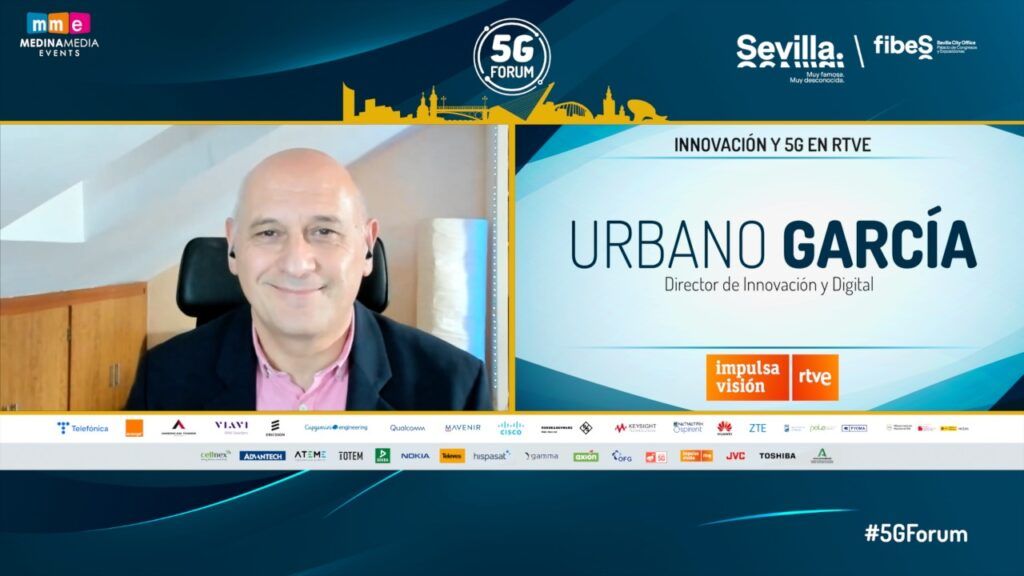
For Urbano García, the function of this direction is precisely to try to promote the change in corporate culture and make that digital transformation so necessary to exist: “we believe that only the media that have true interaction with what we have always called the audience will be able to survive. , which now via engagement becomes a true community with which you have to maintain a continuous and two-way real conversation. We have to go to a mobile-first digital concept or a new way of thinking. Even narrating the stories to be consumed on that device that we all carry in our pockets for as long as it is the smartphone, and that also implies new professional roles, new skills and new innovation profiles”
The 5G Forum will continue until tomorrow, Friday, May 13, with its last virtual day. Those registered for the 5G Forum 2022 will be able to follow this last day by streaming and network through videoconferences with speakers and participants, through the virtual platform created by Medina Media Events. As soon as they are broadcast for the first time, they are made available to virtual attendees in Video on Demand (SVOD) on the Platform of Medina Media Events, the organizer of the event.
The 5G Forum is a privileged opportunity to publicize the successes of each initiative, each company, each university, each project and each city, in an event of international reference and with a first-class showcase. It is promoted by Sevilla City Office and Fibes. It also has the support of Telefónica, Orange, American Tower, Viavi Solutions, Ericsson, Capgemini Engineering, Qualcomm, Mavenir, Rohde & Schwarz, Keysight Technologies, Netmetrix-Spirent, Cisco, Huawei, ZTE, Malaga City Council, Digital Content Center , Fycma, National 5G Observatory, Cellnex, Advantech, Ateme, TOTEM, Dekra, Televes, Hispasat, Nokia, JVC, Toshiba, Axión, Impulsa Vision RTVE, OFG and Evolved 5G.